The Economics and Statistics Division maintains archives of previous publications for accountability purposes, but makes no updates to keep these documents current with the latest data revisions from Statistics Canada. As a result, information in older documents may not be accurate. Please exercise caution when referring to older documents. For the latest information and historical data, please contact the individual listed to the right.
<--- Return to Archive
For additional information relating to this article, please contact:
February 20, 2020EMPLOYMENT INSURANCE, DECEMBER 2019 AND 2019 ANNUAL 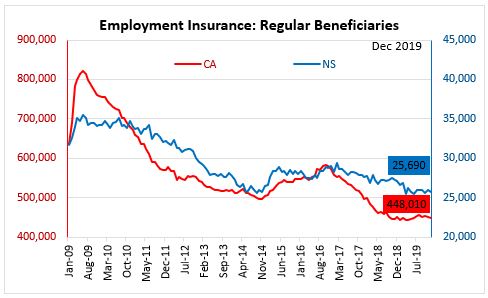
In December 2019, the number (seasonally adjusted) of Nova Scotians receiving regular Employment Insurance (EI) benefits declined by 270 persons (-1.0 per cent) from the previous month to 25,690 and decreased by 1,450 persons (-5.3 per cent) from December 2018. Following a decreasing trend beginning in early 2017, the number of EI beneficiaries in Nova Scotia has been relatively stable in recent months.
The number (seasonally adjusted) of Canadians receiving regular EI benefits in December 2019 was down by 2,410 persons (-0.5 per cent) from the previous month at 448,010. The number of regular EI beneficiaries decreased by 2,150 (-0.5 per cent) from December 2018.
In annual terms, the number of Nova Scotians receiving regular EI benefits declined by 4.7 per cent. Nationally, EI usage declined 3.2 per cent compared to the 2018. In 2019, all provinces except New Brunswick (+1.2 per cent) have seen declines in EI usage, with the largest declines in Newfoundland and Labrador (-7.4 per cent), Alberta (-6.9 per cent), and Saskatchewan (-5.4 per cent).
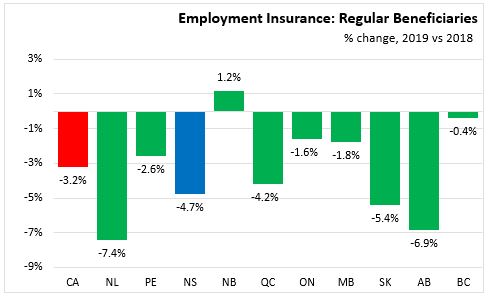
AGE
The bulk of EI beneficiaries in Nova Scotia are aged 25 to 54, who also account for the largest share of the labour force. In December, the number of beneficiaries aged 25-54 decreased by 190 persons, month-to-month. The number of beneficiaries aged 55 and older decreased by 20 persons, and the number of beneficiaries aged 15-24 was decreased by 50 persons compared to the previous month.
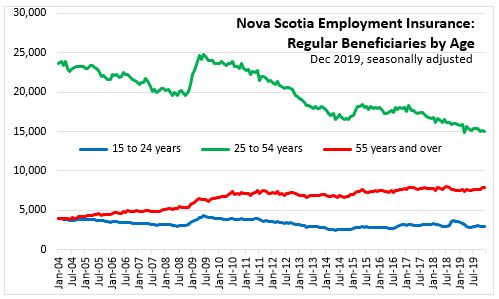
Measured as a share of the labour force, EI usage is more prevalent among older workers (6.6 per cent) than it is among youth (3.8 per cent) or core aged workers (4.8 per cent).
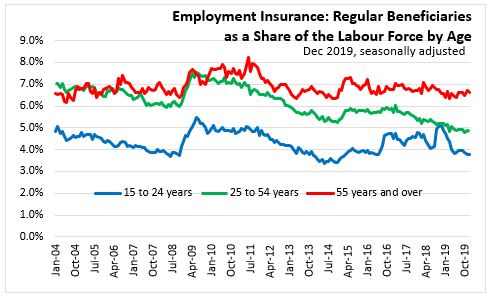
EI BENEFICIARIES AS A SHARE OF THE UNEMPLOYED BY PROVINCE
The number (seasonally adjusted) of Nova Scotians receiving regular EI benefits in December 2019 accounted for 5.1 per cent of the total labour force. In Canada, the number of EI beneficiaries accounted for 2.2 per cent of the total labour force.
In Nova Scotia, EI beneficiaries accounted for 64.7 per cent of the unemployed in December, compared to a Canadian rate of 39.2 per cent. Across the country, EI beneficiaries accounted for the highest share of the unemployed in the Atlantic provinces, led by Prince Edward Island and Newfoundland and Labrador. EI beneficiaries accounted for the lowest share of the unemployed in Ontario, Alberta, and British Columbia.
Note that due to differences in estimation methodology, it is possible for the reported number of EI beneficiaries to exceed the reported number of unemployed in a given jurisdiction.
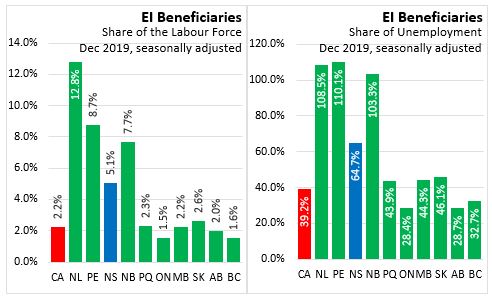
COUNTIES
In 2019, EI usage (regular beneficiaries, unadjusted) was up in Inverness, Guysborough and Antigonish counties compared to last year. Decreases were seen in all other counties, with the largest decline in percentage terms in Annapolis (-10.8 per cent).

Note: Statistics Canada did not release EI by occupation data for Dec 2019 due to quality issue with the data.
Legislative changes to the EI program came into effect in July 2016. While some of these changes affected all EI regions across Canada, eligible claimants in the 15 regions that posted notable increases in unemployment received additional weeks of regular benefits starting in July. More information on the 2016 EI changes is available on Employment and Social Development Canada's (ESDC) website. As a result of the changes to the EI program, historical comparisons are not recommended, except in areas outside of the 15 EI regions where eligible claimants received additional weeks of benefits. These 15 EI regions are Newfoundland and Labrador, Northern Ontario, Sudbury, Northern Manitoba, Southern Saskatchewan, Northern Saskatchewan, Saskatoon, Southern Alberta, Northern Alberta, Calgary, Edmonton, Southern Interior British Columbia, Northern British Columbia, Whitehorse and Nunavut.
Statistics Canada data portal: 14-10-0011-01 (Age, Province), 14-010-0337-01 (Occupation), 11-10-0014-01 (County level)
<--- Return to Archive